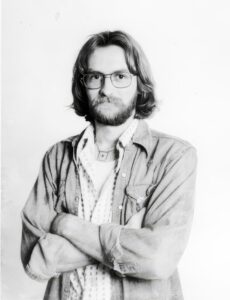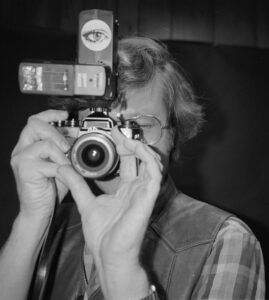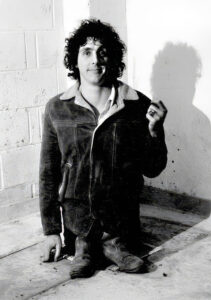Waxing and Waning
a memoir by Colin Campbell
I fled my toxic situation in Detroit in October 1975 by taking a ten-day bus ride to Santa Barbara where my brother Scott lived. When I arrived I called him from the pay phone at the Greyhound station: “I’m here,” I said.
Scott and I were always doing artistic things when we were kids. When we went to our father’s art studio on the 47th floor of a Detroit skyscraper on Sunday visitation days, there were acres of different-colored pencils and pastel chalks that the artists used for making mock-ups of ads sitting unguarded. We drew and painted and sketched. We liked using the studio’s industrial-grade Lucigraph machine to make accurate drawings.
One summer at home we re-fought the Civil War. I went to the butcher and bought 12 feet of butcher paper. Scott and I drew a line down the middle the long way and flipped a coin to see who was blue and who was gray, and we drew horses and soldiers and guns and wagons and cannons battling until the end of the paper, using crayons and colored pencils and pastels filched from the art studio.

Starting when he was 13, using our father’s connections, Scott worked as a mat-room boy at major Detroit design studios during the summers. After high school he was drafted and spent a tour in combat in Vietnam. When he got out of the Army he used the GI benefits to go to Brooks School of Photography in Santa Barbara.
Now, two years after his graduation, he had his own art-studio business in Santa Barbara: Scott Campbell & Associates.
It was lunchtime by the time Scott arrived at the bus station. He brought Henry to introduce me to him and we went to lunch together.
 Henry was the Director of Photography at California Press. Henry grew up working at his family’s camera shop in Indianapolis. He was drafted into the Army–he was a big man so they made him an MP. After his discharge to he came to Santa Barbara to attend the Brooks Institute of Photography, same school as Scott but different years.
Henry was the Director of Photography at California Press. Henry grew up working at his family’s camera shop in Indianapolis. He was drafted into the Army–he was a big man so they made him an MP. After his discharge to he came to Santa Barbara to attend the Brooks Institute of Photography, same school as Scott but different years.
After lunch we went to Scott’s studio on Padre Street on the second floor of the same building as the offices of California Press. Henry’s photo studio was in the other wing of the same address.
California Press published two quarterly magazines, UNIQUES OF CALIFORNIA and SANTA BARBARA MAGAZINE. Uniques was the cash cow for California Press: a magazine of lush photographs of high-end houses for sale. A real estate shill rag. Santa Barbara Magazine had sent two issues to the news stands, Volume 1, Number 1, and Volume 1, Number 2. When I arrived #3 was in production.
 Scott had one employee, Mark. His father owned an ad agency in Orange County. Mark graduated from UC Irvine with a BA, Fine and Studio Arts. His wife Ingerid owned a jewelry store on State Street.
Scott had one employee, Mark. His father owned an ad agency in Orange County. Mark graduated from UC Irvine with a BA, Fine and Studio Arts. His wife Ingerid owned a jewelry store on State Street.
Henry’s assistant was Jurgen, a burly German guy with a bushy beard. He was still a little uncertain about American culture–he didn’t emigrate to America until he was 13. Months later he showed me his birth certificate from 1939: it had a big swastika watermark behind all the information. He’d worked as a technician at a local aerospace company where he helped build a sensor that went into a space probe that is today still heading away from the Solar System. He had many arcane cameras and specialized lenses and was a precise craftsman with his photography.
The only writer on the staff was Jan, who billed herself modestly as “Janet Planet, Keeper of the Cosmos.” She was 32, divorced, mother of two daughters. Shoulder-length straight blond hair parted in the middle. Blue eyes. Slightly haggard face. I never heard her mention a thing about her ex. She grew up in Avalon on Santa Catalina Island. Deep, raspy smoker’s voice. We were all smokers back then. She’d started by writing newspaper ads for a local real estate agent, then wrote copy for houses going into Uniques magazine, which is where she came into contact with SB Mag. Now she was trying her hand at writing articles.
 This was the gang I worked and caroused with for the next few years. California Press was owned and operated by Dave. He was not part of our creative circle. He was publisher and his main function was to schmooze with realtors and sell ad space to the business community. He gave Henry the assignments to photograph houses for UNIQUES magazine.
This was the gang I worked and caroused with for the next few years. California Press was owned and operated by Dave. He was not part of our creative circle. He was publisher and his main function was to schmooze with realtors and sell ad space to the business community. He gave Henry the assignments to photograph houses for UNIQUES magazine.
He decided which articles were going into SB Mag and assigned writers, but then it was up to us to make the articles and photos and ads appear and paste them into 72 pages each quarter. He was from Fresno, and he was able to print four-color magazines in Fresno at a low price. I never had any info about the actual cost of printing. All I knew was that Josten Yearbook’s unusually low price was accompanied by an iron deadline: Josten’s presses were always running and if your materials didn’t show up for the appointed press run, somebody else’s job would be started immediately and you had to go back onto the waiting list.
My other brother Matt was in Santa Barbara, too, and he and his wife and I rented a house on the same street as Scott and his wife in the Lower Riviera near the County Bowl.
I didn’t have a car. After I got settled in, I walked two miles to the office on Padre Street every day.
I wasn’t really a writer yet when I started. I had no credentials as an editor or writer. The only thing I’d ever published was a humorous essay I wrote when I was 12–my sixth-grade teacher sent it to HIGHLIGHTS FOR CHILDREN magazine and they sent me a $5 check. That was the entirety of my magazine experience.
I’d written retail copy for an in-house Sears regional advertising department for two years. I’d written five or six stories that had been rejected by sci-fi magazines.
But I had a lot of abstract knowledge about magazines even if I didn’t have much hands-on experience. I’d been a voracious reader since I was 4 years old. I was reading a hundred books a year. Magazines mattered. Tuesday was the most important day of the week: the day new magazines arrived at the newsstands. I’d been reading HERE AT THE NEW YORKER (Brendan Gill), a history of the magazine, and it was \ exciting to be working on a new magazine that maybe could become a West Coast version of THE NEW YORKER. That was part of Dave’s megalomania and it was catching.
Scott had touted my skills to the California Press staff and they accepted me on his say-so. One reason I fit in was that Scott, Henry, Mark, Jurgen, and Jan didn’t have the lifelong immersion in magazines like I had. None of the SB Mag staffers had that kind of mania. Their bible was COMMUNICATION ARTS magazine, which showcased exceptional design, advertising, illustration, photography, and typography.
I quickly became part of their cabal whose plot was to force California Press to publish good stuff instead of dreck, no matter how many bottles of Jack Daniels it took.
The premiere Issue #1 of SB Mag had caused a local sensation and sold out, but issue #2 was a letdown and issue #3 was woefully far from completion when I arrived. I jumped in and did a lot of work both in editing and production to get Issue 3 out the door.
I started with proofreading. I found typos and grammatical errors and detected errors of fact and logic. My secret super-power is that I can read really, really fast.
And I did have a lot of hands-on experience at graphic production. I’d learned a lot about typography while working at my father’s studio and I was a whiz at type-speccing from my years writing Sears ads.
Instead of the hot-metal type and ponderous zinc plates produced by outside vendors in my Sears days, California Press was using hot wax production techniques, but the desired end result was the same: printed pages.
As text and photos for Issue Three came in from the type shop and the photographers, we trimmed them to exact size and put them through the rollers of a hot wax machine to coat one side with wax pasted them into precise position onto the double-page layout mats from Josten’s. Our tools were light boxes, Rapidograph pens, burnishers, Xacto knives, Bestine solvent.
 Bestine is a brand name for heptane, a volatile hydrocarbon that will strip wax (and any number of other things) off of just about any surface. You could tell from the smell and the fact that it vaporized in seconds, that this was bad juju. Inhaling it can cause headaches, dizziness, fatigue, nausea, and asphyxiation. We slathered it on every surface, and used it to clean wax off our hands. Maybe it helped make us crazy.
Bestine is a brand name for heptane, a volatile hydrocarbon that will strip wax (and any number of other things) off of just about any surface. You could tell from the smell and the fact that it vaporized in seconds, that this was bad juju. Inhaling it can cause headaches, dizziness, fatigue, nausea, and asphyxiation. We slathered it on every surface, and used it to clean wax off our hands. Maybe it helped make us crazy.
Janet Planet was writing an article about The Brotherhood of the Sun, a crackpot cult taking advantage of young homeless by using them as farm serfs and selling produce at a store. The Brotherhood was a shoestring operation, they wanted you to believe, except for a few crumbs that the founder managed to set aside to buy himself a 90-foot sailboat.
Jan was able to generate an emotional empathy to get the various Brotherhood folks to talk frankly with her. She was accustomed to stringing together descriptions of houses for Uniques; I forced her to keep rewriting the article because there was too much extraneous detail instead of relevant meat.
We distilled it down and she was miffed at my editorial demands. But then a couple days after the issue was published, she and I were having drinks at a bar on State Street that had free canapes at Happy Hour. We were starving artists, after all. I gradually became aware that the people at the next booth were talking about her article. I was so jealous. Jan didn’t notice so I told her to listen and she fell into weeping. Her article was lyrical and uncritical; the Brotherhood loved it and it was controversial in the community, the first SB Mag item that caused any notice. I was so jealous.
The issue turned out so well that I was officially hired as Associate Editor for the next issue. I had the joy of acceptance: for the first time in my life I was in a situation where people valued my true talents. I had a new family. I even had business cards (in lieu of a paycheck).
However, it became clear that there wasn’t enough money at the ‘zine and I had to focus my efforts on my brother’s adbiz and graphics clients: Skor-Mor Toys, Frimples restaurant, Piccadilly Square shopping center.
I studied every textbook about copywriting and read the memoirs of famous copywriters. CONFESSIONS OF AN ADVERTISING MAN by David Ogilvy, REALITY IN ADVERTISING by Rosser Reeves, THE COPYWRITERS HANDBOOK, by Robert Bly. I applied the basic principles of sound copywriting to everything I wrote.
I wrote package covers and rulebooks for a dozen board games. One of the projects was a series of tricks for magicians. I had to learn to do the tricks in order to write explanations of how to use the gadgets. We used photos of Jurgen as “Professor Pip” on the boxes.
![]()
I wrote a rulebook for Mah Jongg…that was a challenge. I had no idea how you play Mah Jongg. I went to the library and found all kinds of books and every one of them had a different set of rules. So I made my own set of rules. Who knows if anybody was ever able to play the game according to those rules.
A restaurant was bought by a wealthy family with the intent of making it into a chain. They solicited seven ad agencies for help, including Scott. He and I put together a proposal and they liked the slogan I came up with. We were hired to create a 16-page brochure intended to sway investors and bank executives. It worked well enough so that the restaurant opened two branches and I wrote several radio spots and newspaper and magazine ads for them.
The restaurant guy was the oldest son of a very wealthy family and they bought the restaurant for him to convert into a chain like a magnate. As time went on I discovered that the family went along with his restaurant idea in order to get him out of their hair. He didn’t drive, he had a private plane and a pilot who was also his bodyguard and procurer. The project got ickier the longer I worked on it.
We started working on the next issue of SB Mag in the early spring of 1976 and I wrote my first article. Dave had talked the Santa Barbara Arabian Horse Association into buying several full pages of ad space in exchange for an article about them.
I went to horse ranches over the hill in Solvang and Santa Ynez and interviewed the Arabian breeders. I read a ton of stuff about Arabian horses. When I was a kid on the farm I rode my horse twice a week so I had a connection with horses.
A Montecito matron submitted an article about a glassblower. There was hardly anything in the article about the glassblower, just the matron’s ruminations about the current state of the art industry. So I went to the glassblower’s studio and interviewed him and his two employees and filled the article with the nuts and bolts of crafting art glass into Tiffany-style glass lamps.
I edited our interview with Tennessee Williams. Dave heard the playwright was in town and sent this good-looking young guy to interview him. I don’t think the interviewer knew that Williams was gay, he was all enthused about how open and accessible Williams was.
The back cover of the magazine was a full-page ad I wrote for Piccadilly Square, an arcade at 813 State Street.
The magazine was published on June 20, long overdue.
I went to the one-year anniversary party Dave threw–it was the first time I was ever at his house. There was nowhere for guests to sit–the 3,000 square foot home in the hills of the Riviera neighborhood had no furniture except for a bed, two chairs, and a table.
There was plenty of booze and snacks so we all stood around drinking. I asked him why he was living such a Spartan home life and he gabbed about how important it was to maintain the illusion in order to cater to the wealthy demographic he was trying to seduce.
I went into a deep depression after the mag was published. Postpartum blues. I got no exhilaration out of it. I was drinking and smoking too much, I was up to three packs a day. I went to the free clinic and tried to explain what was wrong and the doctor shrugged and said, “How many valium do you want?”
I didn’t want to add another addiction. I stuck with my regular problems of bourbon, Marlboro hardpack, and weed.
Over the next two years the magazine won Maggie awards from the Western Publications Association–BEST NEW MAGAZINE, and the next year BEST CITY MAGAZINE.